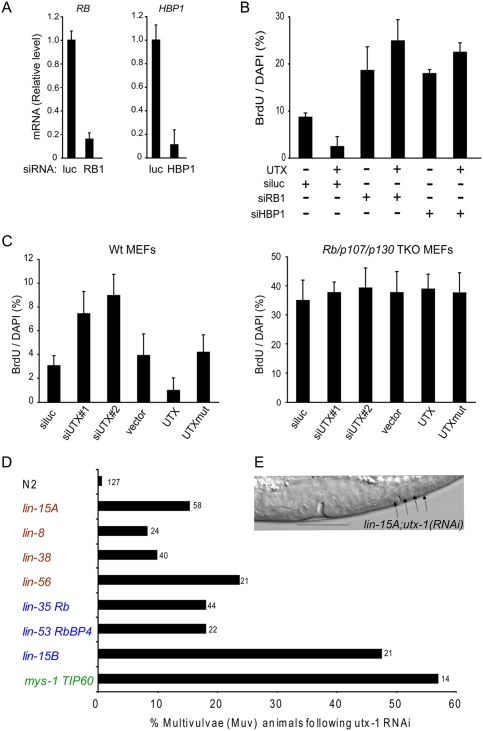Figure 4.
Genetic interaction between UTX, RB, and RB-binding proteins. (A) Depletion of RB1 or HBP1 by siRNAs. (siluc) Control siRNA targeting luciferase. (B) RB or HBP1 depletion reverses UTX-mediated cell cycle arrest. Quantifications of percentage of cells in S phase as measured by BrdU incorporation is shown. n = 1000+. (C) UTX modulation of cell cycle progression in mouse embryonic fibroblasts (MEFs) requires the Rb family members. (Left) Wild-type MEFs. (Right) Rb, p107, and p130 triple knockout (TKO) MEFs. (D) C. elegans UTX-1 is synMuv. RNAi of utx-1 was performed on eight characteristic synMuv strains and N2 wild-type worms. Wild-type worms were exposed to utx-1 RNAi and showed a very weak Muv phenotype (<1% penetrance). Strains representing class A (lin-15A, lin-8, lin-38, and lin-56; genes labeled in red), class B (lin-35 Rb, lin-53 RbBP4, and lin-15B; genes labeled in blue), and class C (mys-1 TIP60; gene label in green) were used to test for UTX-1 synMuv activity. All of these strains present a normal vulva (Ferguson and Horvitz 1989), except for mys-1, which produces <10% Muv (Ceol and Horvitz 2004). Penetrance of the synMuv interactions vary between 8% and 24% for class A and 18% and 48% for class B, and is 57% for class C. Overall, utx-1 genetically interacts with classes A, B, and C, and behaves similarly to set-16 mll (K Fisher and GB Poulin, pers. comm.). The number of worms analyzed is indicated above each bar. (E) Photomicrograph of representative synMuv phenotype in an early L4 stage worm. Arrows indicate extra cells adopting the vulval fate. The normal vulva is underlined.

